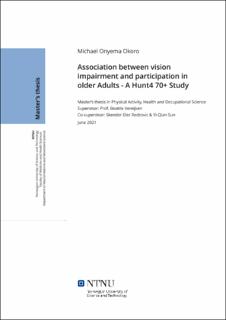| dc.description.abstract | Mål: Målet med denne studien var å undersøke om det er en sammenheng mellom synshemming (VI) og deltakelse hos eldre voksne, avhengig av graden av VI, ved bruk av et stort, norsk datasett.
Metode: Denne tverrsnittsstudien inkluderte synshemmede eldre voksne (70+ år, n = 6152) som deltok i HUNT4 70+ og TRONDHEIM 70+ helsestudier, som var en del av den fjerde datainnsamling bølgen i HUNT-studien (2018 -2019). I samsvar med World Health Organisations internasjonale klassifisering av funksjonshemming og helse (ICF), vurderte jeg deltakelse på to av de fire domenene, nemlig hjemmeliv og samfunn, sosialt og samfunnsliv. Omfattende informasjon om deltakelse var basert på spørsmål om aktiviteter i dagliglivet (ADL), livsstil, helsestatus og kroniske tilstander. For å vurdere assosiasjonene ble informasjon om graden av VI (eksponering) undersøkt med en grov logistisk regresjonsanalyse i forhold til deltakelse domener (utfall), etterfulgt av justert logistisk regresjonsanalyse. I tillegg vurderte vi også deltaker nivået rapportert av deltakerne.
Resultater og diskusjon: Alvorlig VI var signifikant assosiert med økt risiko for å delta mindre i hjemmelivet (OR = 1,62 95% KI = 1,18 - 2,22) etter justering for kovariater (alder, kjønn, utdannelse, leddsmerter, helsetilstand muskuloskeletale smerter, motor funksjonshemning,) men hadde ingen signifikant innflytelse på deltakelse i samfunn, sosialt liv og samfunn (OR = 1,37, 95% KI = 0,89 - 2,12). Risikoen redusert for moderat VI (OR 1,03; 95% KI = 0,83 til 1,28) og svakt VI (OR 1,04; 95% KI 0,88 til 1,24) i hjemmet, men ikke statistisk signifikant. En mindre utvalgsstørrelse for alvorlig svekkelse (n = 350) sammenlignet med moderat og liten VI kan være en årsak til dette. Deltakernes svar viste at eldre mennesker med VI deltok mer i hjemmelivet sammenlignet med samfunnet, det sosiale og det samfunnsliv.
Konklusjon: Deltakelse er viktig for å opprettholde livskvalitet og sunn aldring. Det kan også informere om bedre politikkutforming. Denne studien viste at graden av VI er assosiert med økt risiko for å delta mindre i hjemmelivet, men har ingen effekt på samfunnet, det sosiale og det borgerlige livet. Disse resultatene understreker behovet for flere studier for å undersøke årsakene til at VI har større innvirkning på hjemmelivet sammenlignet med samfunnet, det sosiale og det samfunnsliv.
Stikkord: Deltakelse, Eldre voksne, Synshemming, Daglige aktiviteter, HUNT4, ICF. | |
| dc.description.abstract | Objective: The aim of this study was to examine whether there is an association between vision impairment (VI) and participation in older adults, depending on the degree of VI, using a large, Norwegian dataset.
Method: This cross-sectional study included vision impaired older adults (70+ years, n = 6,152) who participated in the HUNT4 70+ and TRONDHEIM 70+ health studies, which were part of the fourth data collection wave of the HUNT study (2018 -2019). In accordance with the World Health Organizations international classification of functioning disability and health (ICF), we assessed participation in two of the four domains, namely domestic life and community, social and civic life. Comprehensive information about participation was based on questions concerning activities of daily living (ADL), lifestyle, health status, and chronic conditions. To assess the associations, information on the degree of VI (exposure) was examined with a crude logistic regression analysis in relation with participation domains (outcome), followed by adjusted logistic regression analysis. In addition, we also assessed the level of participation reported by the participants.
Results and Discussion: Severe VI was significantly associated with increased risk of participating less in domestic life (OR = 1.62 95%CI = 1.18 – 2.22) after adjusting for covariates (age, sex, education, joint pain, health status musculoskeletal pain, motor ability impairment,) but had no significant influence on participation in community, social and civic life (OR = 1.37, 95% CI = 0.89 – 2.12). The risk decreased for moderate VI (OR 1.03; 95%CI =0.83 to 1.28), and slight VI (OR 1.04; 95%CI 0.88 to 1.24) in domestic life although not statistically significant. A smaller sample size for the severe impairment (n=350) compared to moderate and slight VI could be a reason for this. Participant’s responses showed that older people with VI participated more in domestic life compared to community, social and civic life.
Conclusion: Participation is important for maintaining quality of life and healthy aging. It could also inform better policy making. This study showed that the degree of VI is associated with increased risk participating less in domestic life, but has no effect on community, social and civic life. These results underline the need for more studies to investigate the reasons why VI has more impact on domestic life compared to community, social and civic life.
Key words: Participation, Older adults, Vision impairment, Activities of daily living, HUNT4, ICF. | |
